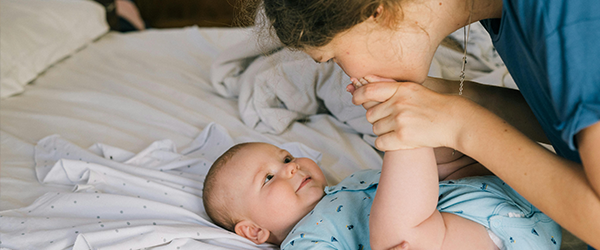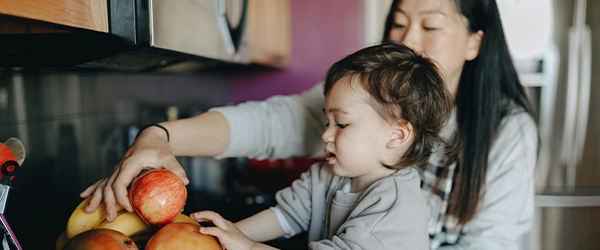Milestones in a child’s language development
6 minute readEvery child has their own pace
When we consider what a child achieves in the first few years of life it’s pretty miraculous. Not only do they begin to acquire their first motor skills, but they are also confronted with one of the most complex tasks in their entire development: language acquisition.[1] Just as motor development varies from child to child, so does language development. Some children begin to speak words towards the end of their first year, while others can take until the age of three[2].
Language development in a nutshell
The relationship with caregivers is the most important basic requirement for healthy language development. Children want to establish relationships with their caregivers, communicate with them and learn their language. These caregivers are therefore the first language role models and can have a major influence on the child’s language development.
Babies are learning language even before they’re born! In the womb, they can distinguish human voices and sounds, setting the stage for future communication. After birth, crying isn’t just about needs, it’s vocal training! This early practice helps babies explore sounds and prepare for speech. Even those adorable gurgles, laughs, and babbles aren’t just playful sounds. They’re crucial for developing the building blocks of language – vowels and consonants. [3]
At around 3-6 months, they enter the first babbling phase, where they’re captivated by vocal sounds! This is the perfect time to talk, sing, and recite rhymes with your little one.[5]
Here’s why:
Recognizing Pitch: Babies can pick up on changes in your voice, like high-pitched excitement or soothing tones.
Learning Melodies: Rhymes and songs introduce them to the rhythm and flow of language.
Building Bonds: Every interaction strengthens your connection and fosters a love for communication.

In the second babbling phase (at around 6 to 10 months), the child forms its first sound chains: “poo” is chained together to form “poo-poo-poo”.[6] From now on, the baby begins to happily have babble conversations with the family using this selection of sounds.[7] It imitates the sounds in the environment and develops its first understanding of language: the baby slowly understands individual words from everyday life (for example “pacifier” or “milk bottle”).
Towards the end of their first year, a child begins to know the names of everyday objects and people. They slowly learn to narrow down the meanings of words: Everyday activities such as “eat” and “sleep” have an increasingly tangible meaning[8].
In the coming months, you’ll witness amazing changes. Your little one is figuring out what words truly mean, becoming more accurate every day. They’re also paying close attention, ready to follow simple instructions like “Get the shoe!” Best of all, picture books become interactive experiences! Expect excited pointing and recognition of familiar objects they’ve learned about.
Around the age of two, once your child knows about 50 words, something magical happens – their language skills take off! Over the next three years, their vocabulary will grow at an incredible pace, [9]
Between the ages of two and five, your child’s vocabulary will skyrocket. They’ll learn thousands of new words, adding to their knowledge every single day! Soon, those adorable first words become simple sentences. Even with some endearing mispronunciations, their curiosity about the world grows alongside their ability to ask about it. Get ready for deeper conversations as they grasp the basics of grammar and build more complex sentences. [10]

At the age of around five to six, a child’s language development is largely complete and they can tell stories, recount experiences and repeat what they’ve heard. From now on, the narrative becomes more and more consistent and comprehensible: between the ages of six and seven, the child now provides general information about the time, place and people involved. The child’s narratives become increasingly comprehensible due to their linear structure. .[11] During this time, children also begin to become aware of the multiple meanings of words. .[12] And from the age of eight and nine, children understand that words and sentences can also be used ironically or sarcastically – and thus learn to use irony and sarcasm themselves. .[13]
What an extraordinary achievement!
Temporary stuttering is part of the process!
If your child falters when speaking, this is initially no cause for concern. Temporary stuttering is part of normal speech development. Over 50 per cent of children can stutter between the ages of 2.5 and 4 years.[14] Forming sentences independently, searching for words and putting them in the right order can be a great challenge for children. It should also be remembered that a child’s understanding of language is always somewhat more advanced than their ability to express themselves.
In most cases, this stuttering only lasts a few weeks – it rarely lasts up to six months.[13] During this time, parents and carers should be patient with their children. To prevent the child from becoming discouraged and the stuttering from getting worse, parents and carers should not let the child repeat sentences, but only confirm the content of their statements. However, if the stuttering persists for longer than six months, parents and carers should seek advice from a specialist. [15]
You can find out more interesting facts about language development in children in this blog article here.

Our colorful picture dictionary
Our book, “My 100 words” celebrates the wonderful world of words. The book takes the child on an exciting journey through the seasons. In a playful way, children can explore objects, colors and more. Our picture dictionary is designed to enable children to expand their vocabulary with ease and enjoyment.
The colorful illustrations help children to remember individual words faster and better – because even small children can decode and absorb pictures intuitively. If pictures are combined with new words, they form a unit for the child that they can process and memorize even faster [16].
A wonderful book to easily expand vocabulary!
Sources
[1] vgl. Dittmann 2010: 9.
[2] vgl. Largo 2007: 389f.; 367.
[3] vgl. Largo 2007: 377ff.; vgl. auch Tracy 2007: 67; vgl. auch Pauli/Bickes 2009: 49ff.
[4] vgl. Sachse et al. 2020: 16ff.
[5] vgl. Largo 2007: 383.
[6] vgl. Largo 2007: 386.
[7] vgl. Largo 2007: 378ff.
[8] vgl. Largo 2007: 389f.
[9] vgl. Largo 2007: 401f.
[10] vgl. Largo 2007: 403.
[11] vgl. Reese et al. 1993: 425ff.
[12] vgl. Ely/McCabe 1994: 30ff.
[13] vgl. Glenright/Pexman 2010: 447ff.
[14] vgl. Largo 2007: 414.
[15] vgl. Largo 2007: 412.
[16] vgl. Largo 2007: 413.
Dittmann, J.: Der Spracherwerb des Kindes. Verlauf und Störungen. 3. vollständig überarb. Aufl. München (2010).
Ely, R. und McCabe, A.: The language play of kindergarten children. In: First Language 14 (1994): 19-35.
Glenright, M. und Pexman, P. M.: Development of children’s ability to distinguish sarcasm and verbal irony. In: Journal of Child Language 37 (2010): 429-451.
Largo, R. H: Babyjahre. Entwicklung und Erziehung in den ersten vier Jahren. München (2007).
Pauli, U. and Bickes, H.: Erst- und Zweitspracherwerb. Stuttgart (2009).
Reese, E. et al.: Mother-Child Conversations About the Past: Relationships of Style and Memory over Time. In: Cognitive Development 8 (1993): 403-430.
Tracy, R.: Wie Kinder Sprachen lernen, und wie wir sie dabei unterstützen können. Tübingen (2007).





